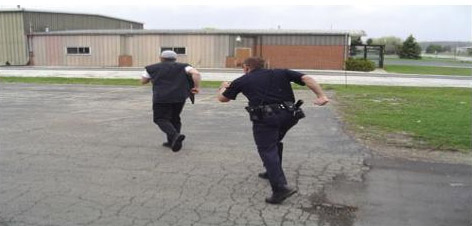
The pursuit of a fleeing suspect is an inherent danger facing law enforcement officers. Case in point: In 2011 alone, SFPD officers in three separate incidents came under fire while attempting to apprehend a fleeing suspect. Yet in only one of those incidents did officers initially confront a suspect they knew to be armed. Superior tactics led to officer survival in each of the deadly force encounters because officers quickly exited the “kill zone” and moved to a position of advantage. This serves as a reminder that officers must have shared situational awareness during all suspect encounters, not just the ones they know will be high risk.
Apprehension vs. Containment
There are two pursuit modes when a suspect flees on foot: apprehension mode and containment mode. Apprehension mode is the pursuit of a suspect with the intent to take the suspect into custody as quickly as possible and without delay. Containment mode is the pursuit of a suspect with the intent to maintain observation and contain the suspect for later arrest. Depending on the circumstances and the rapidly changing nature of any given foot pursuit, officers must quickly assess then decide which is the best course of action to take. This may include transitioning from apprehension to containment mode or vice versa.
Communication between partners and back up units is critical. Just because one officer sees the suspect draw a handgun does not mean his partner saw the same thing. If nothing else—officers must broadcast their location. Information including unit identifier, the type of crime/suspect
that is involved, and the resources that are needed should be broadcast as soon as possible. If officers lose sight of the suspect during a pursuit, even briefly, the danger increases significantly and the threat of ambush becomes high.
Barricaded Suspect Incidents

If an armed suspect enters a building or otherwise becomes “barricaded,” locking down the location and establishing a perimeter, in most cases, is the best option. [A barricaded suspect incident is defined in General Orders as a situation where an armed suspect (gun, knife, bomb, etc.) takes up a defensive position. The suspect is intent upon evading arrest and is presenting a deadly hazard to arresting officers.] The Event Management Manual explains: “Once a barricaded subject is isolated, there is plenty of time; don’t rush.” I would add, however, that officers need to stay highly alert because these situations are often extremely fluid. Just because the suspect chooses to become barricaded does not guarantee he will stay contained.
If the suspect goes on the offensive, nothing precludes officers from using reasonable force to protect themselves and others. A suspect initiating an attack may require immediate action. Rapid deployment has been defined as the following: “The swift and immediate deployment of law enforcement resources to ongoing, life-threatening situations where delayed deployment could otherwise result in death or serious bodily injury to innocent persons.”
But absent exigent circumstances described above, there is no urgency for an expedited entry into a barricaded suspect location. Barricaded suspect situations are critical incidents requiring a coordinated response from Special Operations Bureau (including Specialists, Tactical Company
and Hostage Negotiators). Time can be a valuable asset in a critical incident—if presented with the opportunity to slow things down, take it!
Establishing a good perimeter (securing both entry and exits), setting up the operational command post, staging areas for responding units, and gathering/disseminating timely intelligence are all vital to ensuring successful outcomes. And all are tasks being done before most tactical teams even arrive.
“All things are ready, if our minds be so.”—William Shakespeare
Do you discuss with your partner officer safety tactics such as contact and cover before you take on a suspicious person? Does your watch or unit regularly debrief after critical incidents to discuss what went right and what can be done better? My good friend Sergeant Phil Pera wrote about debriefings in a prior Journal article: “Chalk Talk.” Debriefings are an important tool because the odds of success and survival greatly increase when we react to arrest situations based on sound training and preparation. Stay safe out there!

